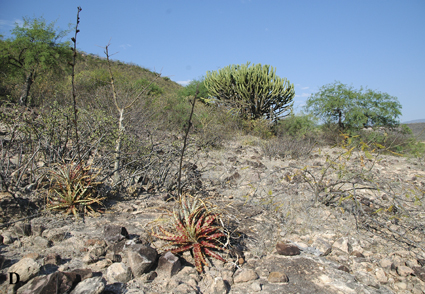Abstract
Epitypes are proposed for two species of Hechtia: H. subalata and H. jaliscana, both endemic to Western Mexico. The holotypes of both species consist of fruiting specimens. While the female flowers of both species are extremely similar, the staminate ones are noticeable different: we select staminate vouchers as epitypes to clearly circumscribe both taxa. As a result of the delimitation of the concept Hechtia subalata and its geographical distribution, we identify a new species from Durango, Mexico, previously misidentified as Hechtia subalata: Hechtia marthae. We provide images portraying plant parts of all species, as well as photographs in habitat. Finally, assessments of the conservation status of the three species sensu IUCN criteria are included.
References
Baker, J.G. (1889) Handbook of the Bromeliaceae. 243 pp. [https://www.biodiversitylibrary.org/page/35547198#page/156/mode/1up]
Espejo-Serna, A., López-Ferrari, A.R. & Ramírez-Morillo, I. (2008) Dos nuevas especies de Hechtia (Bromeliaceae; Pitcairnioideae) del centro de México. Acta Botanica Mexicana 83: 49–61. https://doi.org/10.21829/abm83.2008.1060
Espejo-Serna, A., Martínez-Correa, N. & López-Ferrari, A.R. (2010) Neotypification of Hechtia podantha (Bromeliaceae). Journal of the Botanical Research Institute of Texas 4: 221–223.
Fatzer, D.M. (1996) An analysis of seed morphology and systematic relationships in Hechtia (Bromeliaceae). M. S. Thesis. University of New Orleans. USA.
Givnish, T.J., Millam, K.C., Berry, P.E. & Systma, K.J. (2007) Phylogeny, adaptive radiation, and historical biogeography of Bromeliaceae inferred from ndhF sequence data. Aliso 23: 3?26. https://doi.org/10.3732/ajb.1000059
Gorocica, E.A. (2017) Morfología de semillas en Hechtia Klotzsch (Hechtioideae: Bromeliaceae). Bachelor Thesis. Instituto Tecnológico de Conkal, Mérida, Yucatán, 75 pp.
Gouda, E.J., Butcher, D. & Gouda, C.S. (2021 [cont. updated]) Encyclopaedia of Bromeliads, Version 4. Available from: http://bromeliad.nl/encyclopedia/ University Botanic Gardens, Utrecht (accessed 1 April 2021)
Hernández-Cárdenas, R.A., Siekkinen, A., López-Ferrari, A.R. & Espejo-Serna, A. (2020) Five New Species of Hechtia (Bromeliaceae; Hechtioideae) from Guerrero, Mexico. Systematic Botany 45: 466–477. https://doi.org/10.1600/036364420X15935294613608
INEGI (Instituto nacional de estadística, geografía e informática) (2001) Conjunto de Datos Vectoriales Fisiográficos. Continuo Nacional. Escala 1:1’000,000. Serie I. Instituto Nacional de Estadística y Geografía, Aguascalientes. Available from: http://www.inegi.gob.mx (accessed 14 October 2021)
IUCN Standards and Petitions Committee (2019) Guidelines for Using the IUCN Red List Categories and Criteria. Version 14. Prepared by the Standards and Petitions Committee. Available from: http://www.iucnredlist.org/documents/RedListGuidelines.pdf (accessed 3 August 2019)
Klotzsch, J.F. (1835) Hechtia, eine neue Gattung der Bromeliaceen. Allgemeine Gartenzeitung 3: 401–403.
Martínez-Correa, N. (2008) Sistemática del complejo de especies de Hechtia podantha Mez (Pitcairnioideae, Bromeliaceae). M. S. Thesis. México City, México: Universidad Autónoma Metropolitana.
McVaugh, R. (1989) Bromeliaceae to Dioscoreaceae, Flora Novo-Galiciana 15. University of Michigan Press. Ann Harbor, 398 pp.
Mez, C. (1896) Bromeliaceae. In: De Candolle, A.L.P.P. & De Candolle, A.C.P. (Eds.) Monographiae Phanerogamarum Prodromi nunc continuatio, nunc revisio, vol. 9. Sumptibus G. Masson, Paris, 990 pp.
Morrone, J.J., Escalante, T. & Rodríguez-Tapia, G. (2017) Mexican biogeographic provinces: Map and shapefiles. Zootaxa 4277: 277–279. https://doi.org/10.11646/zootaxa.4277.2.8
QGIS Development Team (2019) QGIS Geographic Information System. Open Source Geospatial Foundation Project. Available from: http://qgis.osgeo.org (accessed 14 October 2021)
Ramírez-Morillo, I., Jiménez, C.F., Carnevali Fernández-Concha, G. & Pinzón, J.P. (2014) Three new species and growth patterns in Hechtia (Bromeliaceae: Hechtioideae). Phytotaxa 178: 113–127. https://doi.org/10.11646/phytotaxa.178.2.3
Ramírez-Morillo, I., Carnevali, G., Pinzón, J.P., Romero-Soler, K., Raigoza, N., Hornung-Leoni, C., Duno, R., Tapia-Muñoz, J.L. & Echevarría, I. (2018a) Phylogenetic relationships of Hechtia (Hechtioideae; Bromeliaceae). Phytotaxa 376: 227–253. https://doi.org/10.11646/phytotaxa.376.6.1
Ramírez-Morillo, I., Carnevali, G., Pinzón, J.P., Romero-Soler, K., Raigoza, N., Hornung-Leoni, C., Duno, R. & Tapia-Muñoz, J.L. (2018b) The reestablishment of Bakerantha, and a new genus in Hechtioideae (Bromeliaceae) in Megamexico, Mesoamerantha. Harvard Papers in Botany 23: 301–312. https://doi.org/10.3100/hpib.v23iss2.2018.n15
Rzedowski, J. (1978) Vegetación de México. Limusa México, D.F. 432 pp. Available from: https://www.biodiversidad.gob.mx/publicaciones/librosDig/pdf/VegetacionMx_Cont.pdf (accessed 14 October 2021)
Scharf, U. & Gouda, E.J. (2008) Bringing Bromeliaceae back to homeland botany. Journal of Bromeliad Society 58: 123–129.
Smith, L.B. (1934) Studies in Bromeliaceae –V. Contributions from the Gray Herbarium of Harvard University 104: 71–83.
Smith, L.B. (1937) Studies in the Bromeliaceae – VII. Contributions from the Gray Herbarium of Harvard University 117: 3–33.
Smith, L.B. (1938) Bromeliaceae, in Britton. North American Flora 19: 97–145.
Smith, L.B. (1964) Notes on Bromeliaceae–XII. Phytologia 10: 454–488. [https://www.biodiversitylibrary.org/page/13190376#page/9/mode/1up]
Smith, L.B. & Downs, R.J. (1974) Pitcairnioideae (Bromeliaceae). In: Flora Neotropica Monograph 14, Part 3. Haffner Press, New York, 658 pp.
Thiers, B. (2021 [continuously updated]) Index Herbariorum: A global directory of public herbaria and associated staff. New York Botanical Garden’s Virtual Herbarium. Available from: http://sweetgum.nybg.org/science/ih/ (accessed 9 January 2020)
Turland, N.J., Wiersema, J.H., Barrie, F.R., Greuter, W., Hawksworth, D.L., Herendeen, P.S., Knapp, S., Kusber, W.-H., Li, D.-Z., Marhold, K., May, T.W., McNeill, J., Monro, A.M., Prado, J., Price, M.J. & Smith, G.F. (eds.) (2018) International Code of Nomenclature for algae, fungi, and plants (Shenzhen Code) adopted by the Nineteenth International Botanical Congress Shenzhen, China, July 2017. Regnum Vegetabile 159. Glashütten: Koeltz Botanical Books. https://doi.org/10.12705/Code.2018
Villaseñor, J.L. (2016) Checklist of the native vascular plants of México. Revista Mexicana de Biodiversidad 87: 559–902. https://doi.org/10.1016/j.rmb.2016.06.017


